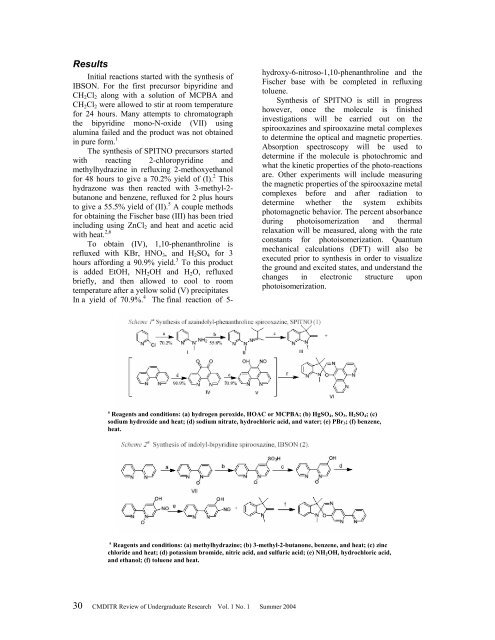CMDITR Review of Undergraduate Research - Pluto - University of ...
CMDITR Review of Undergraduate Research - Pluto - University of ...
CMDITR Review of Undergraduate Research - Pluto - University of ...
Create successful ePaper yourself
Turn your PDF publications into a flip-book with our unique Google optimized e-Paper software.
Results<br />
Initial reactions started with the synthesis <strong>of</strong><br />
IBSON. For the first precursor bipyridine and<br />
CH 2 Cl 2 along with a solution <strong>of</strong> MCPBA and<br />
CH 2 Cl 2 were allowed to stir at room temperature<br />
for 24 hours. Many attempts to chromatograph<br />
the bipyridine mono-N-oxide (VII) using<br />
alumina failed and the product was not obtained<br />
in pure form. 1<br />
The synthesis <strong>of</strong> SPITNO precursors started<br />
with reacting 2-chloropyridine and<br />
methylhydrazine in refluxing 2-methoxyethanol<br />
for 48 hours to give a 70.2% yield <strong>of</strong> (I). 2 This<br />
hydrazone was then reacted with 3-methyl-2-<br />
butanone and benzene, refluxed for 2 plus hours<br />
to give a 55.5% yield <strong>of</strong> (II). 5 A couple methods<br />
for obtaining the Fischer base (III) has been tried<br />
including using ZnCl 2 and heat and acetic acid<br />
with heat. 2,6<br />
To obtain (IV), 1,10-phenanthroline is<br />
refluxed with KBr, HNO 3 , and H 2 SO 4 for 3<br />
hours affording a 90.9% yield. 3 To this product<br />
is added EtOH, NH 2 OH and H 2 O, refluxed<br />
briefly, and then allowed to cool to room<br />
temperature after a yellow solid (V) precipitates<br />
In a yield <strong>of</strong> 70.9%. 4 The final reaction <strong>of</strong> 5-<br />
hydroxy-6-nitroso-1,10-phenanthroline and the<br />
Fischer base with be completed in refluxing<br />
toluene.<br />
Synthesis <strong>of</strong> SPITNO is still in progress<br />
however, once the molecule is finished<br />
investigations will be carried out on the<br />
spirooxazines and spirooxazine metal complexes<br />
to determine the optical and magnetic properties.<br />
Absorption spectroscopy will be used to<br />
determine if the molecule is photochromic and<br />
what the kinetic properties <strong>of</strong> the photo-reactions<br />
are. Other experiments will include measuring<br />
the magnetic properties <strong>of</strong> the spirooxazine metal<br />
complexes before and after radiation to<br />
determine whether the system exhibits<br />
photomagnetic behavior. The percent absorbance<br />
during photoisomerization and thermal<br />
relaxation will be measured, along with the rate<br />
constants for photoisomerization. Quantum<br />
mechanical calculations (DFT) will also be<br />
executed prior to synthesis in order to visualize<br />
the ground and excited states, and understand the<br />
changes in electronic structure upon<br />
photoisomerization.<br />
a Reagents and conditions: (a) hydrogen peroxide, HOAC or MCPBA; (b) HgSO 4 , SO 3 , H 2 SO 4 ; (c)<br />
sodium hydroxide and heat; (d) sodium nitrate, hydrochloric acid, and water; (e) PBr 3 ; (f) benzene,<br />
heat.<br />
a Reagents and conditions: (a) methylhydrazine; (b) 3-methyl-2-butanone, benzene, and heat; (c) zinc<br />
chloride and heat; (d) potassium bromide, nitric acid, and sulfuric acid; (e) NH 2 OH, hydrochloric acid,<br />
and ethanol; (f) toluene and heat.<br />
30 <strong>CMDITR</strong> <strong>Review</strong> <strong>of</strong> <strong>Undergraduate</strong> <strong>Research</strong> Vol. 1 No. 1 Summer 2004




